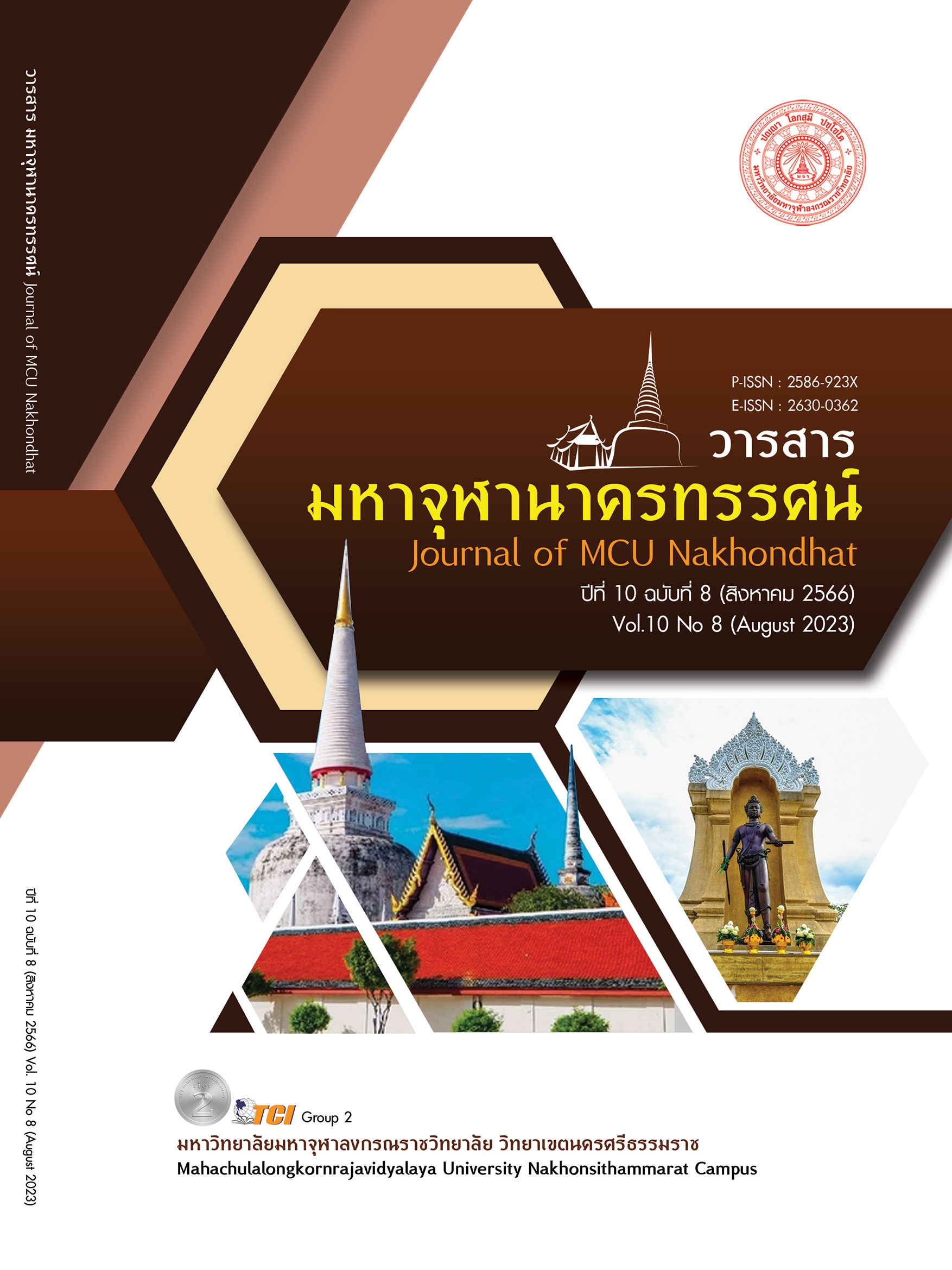THE DEVELOPMENT OF MATHEMATICAL THINKING OF FIFTH GRADE STUDENTS BY USING LEARNING MANAGEMENT BASED ON FRAIVILLIG’S GUIDELINES FOR ADVANCING CHILDREN’S THINKING AND REAL-WORLD CONTEXTS
Main Article Content
Abstract
This research is Quasi-experimental research. The objectives are as follows:
1) compare the mathematical thinking of fifth grade students before and after learning management based on Fraivillig’s guidelines for Advancing children’s thinking and real-world contexts 2) compare the mathematical thinking of fifth grade students after learning management based on Fraivillig’s guidelines for Advancing children’s thinking and real-world contexts with 70 percent criteria. The sample group in this research were 14 students in fifth grade at Watsali School, Suphanburi, in the second Semester of Academic Year 2022, that obtained from purposive sampling. Research tools include learning management plans based on Fraivillig’s guidelines for Advancing children’s thinking and real-world contexts to develop mathematical thinking. There are supporting documents to study the development of mathematical thinking of students, including activity sheets and records of the development of mathematical thinking. And finally, a mathematical thinking test. The data were analyzed by finding arithmetic means, standard deviations, and test hypotheses using t-test for dependent samples and t-test for one sample statistics. The results of the research were as follows: 1) The mathematical thinking of fifth grade students after learning management based on Fraivillig’s guidelines for Advancing children’s thinking and real-world contexts was higher than before at the statistical significance .05 2) The mathematical thinking of fifth grade students after learning management based on Fraivillig’s guidelines for Advancing children’s thinking and real-world contexts was higher than 70 percent criteria at the statistical significance .05. The students had developed their mathematical thinking in every component better respectively.
Article Details

This work is licensed under a Creative Commons Attribution-NonCommercial-NoDerivatives 4.0 International License.
References
กระทรวงศึกษาธิการ. (2551). หลักสูตรแกนกลางการศึกษาขั้นพื้นฐาน พุทธศักราช 2551. กรุงเทพมหานคร: โรงพิมพ์ชุมนุมสหกรณ์การเกษตรแห่งประเทศไทย.
ชนาธิป พรกุล. (2554). การสอนกระบวนการคิด: ทฤษฎีและการนำไปใช้. กรุงเทพมหานคร: สำนักพิมพ์แห่งจุฬาลงกรณ์มหาวิทยาลัย.
ชมนาด เชื้อสุวรรณทวี. (2561). การเรียนการสอนคณิตศาสตร์. กรุงเทพมหานคร: โรงพิมพ์แห่งจุฬาลงกรณ์มหาวิทยาลัย.
ตีรวิชช์ ทินประภา. (2558). เอกสารประกอบการคิดเชิงคณิตศาสตร์ (Thinking Mathematically). กรุงเทพมหานคร: มหาวิทยาลัยราชภัฏสวนสุนันทา.
ปัทมา อนันต์. (2561). การพัฒนากระบวนการเรียนการสอนเพื่อส่งเสริมการคิดเชิงคณิตศาสตร์ของนักเรียนชั้นมัธยมศึกษาปีที่ 3 โดยประยุกต์ใช้การวิจัยอิงการออกแบบ. ใน ปริญญานิพนธ์ปรัชญาดุษฎีบัณฑิต สาขาวิชาการวิจัยและพัฒนาศักยภาพมนุษย์. มหาวิทยาลัยศรีนครินทรวิโรฒ.
พรชัย ภาพันธ์. (2547). เมื่อโรงเรียนเป็นนิติบุคคลทุกคนต้องพร้อมที่จะเปลี่ยนแปลง. วารสารวิชาการ, 7(1), 39-45.
พิทักษ์ รักษาชาติ. (2557). ผลการประยุกต์ใช้ทฤษฎีของฟรายวิลลิกในการพัฒนาความคิดทางคณิตศาสตร์ เรื่อง พาราโบลาของนักเรียนชั้นมัธยมศึกษาปีที่ 3. วารสารการวัดผลการศึกษา มหาวิทยาลัยมหาสารคาม, 20(2), 179-190.
วิจิตร ศรีสอ้าน. (2529). การศึกษาทางไกล. นนทบุรี: มหาวิทยาลัยสุโขทัยธรรมาธิราช.
สถาบันส่งเสริมการสอนวิทยาศาสตร์และเทคโนโลยี. (2555). การวัดประเมินผลคณิตศาสตร์. กรุงเทพมหานคร: ซีเอ็ดยูเคชั่น.
สถาบันส่งเสริมการสอนวิทยาศาสตร์และเทคโนโลยี. (2562). ผลการประเมิน PISA 2018: นักเรียนไทยวัย 15 ปี รู้และทำอะไรได้บ้าง. เรียกใช้เมื่อ 1 สิงหาคม 2565 จาก https://pisathailand.ipst.ac.th/issue-2019-48/
สมบัติ ท้ายเรือคำ และคณะ. (2559). การพัฒนาการรู้คณิตศาสตร์ด้วยวิธีการสอนแบบบูรณาการ. วารสารวิจัยเพื่อพัฒนาสังคมและชุมชน มหาวิทยาลัยราชภัฏมหาสารคาม, 3(7), 11-20.
สำนักงานคณะกรรมการการศึกษาขั้นพื้นฐาน. (2560). มาตรฐานการเรียนรู้และตัวชี้วัดกลุ่มสาระการเรียนรู้คณิตศาสตร์ วิทยาศาสตร์ และสาระภูมิศาสตร์ ในกลุ่มสาระการเรียนรู้สังคมศึกษา ศาสนา และวัฒนธรรม (ฉบับปรับปรุง พ.ศ. 2560) ตามหลักสูตรแกนกลางการศึกษาขั้นพื้นฐาน พุทธศักราช 2551. กรุงเทพมหานคร: โรงพิมพ์ชุมนุมสหกรณ์การเกษตรแห่งประเทศไทย จำกัด.
Delaney, H. (2019). Education for the 21st Century. Retrieved June 18, 2022, from https://www.unicef.org/thailand/stories/education-21st-century.
Fraivillig, J. L. (2001). Strategies For Advancing Children's Mathematical Thinking. Teaching Children Mathematics, 8(7), 454-459.
Greenwood, J. J. (1993). On the Nature of Teaching and Assessing Mathematical Power and Mathematical Thinking. The Arithmetic Teacher, 41(3), 144-152.
Isoda, M. & Katagiri, S. (2012). Mathematical thinking : how to develop it in the classroom. Singapore: WorldScientific.
OECD. (2018). PISA 2021 Mathematics Framework (Draft). Retrieved June 18 , 2022, from https://www.oecd.org/pisa/sitedocument/PISA-2021-mathematics-framework.pdf.
Perkins, D. N. (1986). Knowledge As Design. New York: Routledge.
Thiessen, D. et al. (1993). Elementary Mathematical Methods. New York: Mocmillan.


